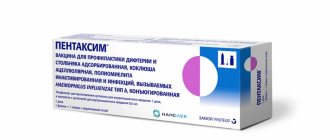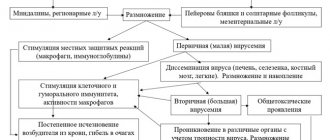General information
Haemophilus influenzae infection (Hib infection) is caused by Haemophilus influenzae type b. It can cause acute infectious diseases - purulent meningitis, pneumonia (pneumonia), epiglottitis (inflammation of the epiglottis), arthritis (inflammation of the joints), as well as purulent damage to the whole body - sepsis. Hemophilus influenzae infection is characterized by predominant damage to the respiratory system, central nervous system and the development of purulent foci in various organs. The bacterium H. influenzae is localized in the nasopharynx, from where it can be transmitted to other people by airborne droplets. Only a very small number of those in whom the pathogen is localized in the nasopharynx develop a disease with clinical manifestations. However, carriers of H. influenzae in the nasopharynx are an important source of spread of the pathogen.
What else is prescribed with this study?
Meningococcus, Haemophilus influenzae, streptococcus (Neisseria meningitidis, haemophilus influenzae, streptococcus pneumoniae, PCR) scraping, quality.
19.52.2. Scraping 2 days
870 ₽ Add to cart
Determination of pathogen sensitivity to antibacterial drugs (DDM)
01. 1 day
490 ₽ Add to cart
Determination of pathogen sensitivity to an expanded range of antibacterial drugs
02. 2 days
600 ₽ Add to cart
Determination of pathogen sensitivity to an expanded range of antibacterial drugs, with determination of the minimum inhibitory concentration (MIC, MIC)
13. 2 days
960 ₽ Add to cart
Sowing the discharge of the upper respiratory tract for microflora (nose, pharynx)
120.2. Scraping 4 days
690 ₽ Add to cart
Chance of getting sick
There are several risk groups for this disease. Firstly, children most often suffer from this infection. According to various studies, carriage of Haemophilus influenzae in children reaches 50%. Infants 6-12 months of age who are bottle-fed and do not receive small additional amounts of maternal antibodies in breast milk have a particularly high risk of developing the most severe forms of infection - pneumonia and meningitis. For this reason, artificial feeding is an additional indication for vaccination against Hib infection, starting from 3 months of age.
People of extreme ages (children under 2 years of age, the elderly) and people with low socioeconomic status are also susceptible to hemophilus influenzae infection. In addition, people with low socio-economic status, extremely weakened and suffering from alcoholism, patients with lymphogranulomatosis (Hodgkin's disease), sickle cell anemia are susceptible to the disease; persons who have undergone splenectomy (removal of the spleen).
The incidence increases in late winter and spring. In recent years, the incidence of morbidity in adults has increased markedly.
Symptoms of hemophilus influenzae infection
Hemophilus influenzae infection is a collective concept that refers to damage to an organ by Pfeiffer's bacillus, so the symptoms of the disease depend on the target organ. The following clinical variants of hemophilus influenzae infection in children are distinguished:
- Pneumonia. H. Influenzae is the second most common cause of bacterial pneumonia in children. Pneumonia can be one- or two-sided, small- or large-focal. Haemophilus influenzae pneumonia is characterized by a severe and long-term course, a high risk of complications (destruction of lung parenchyma, pleurisy, etc.). Children develop a cough (at first dry, later with sputum), symptoms of general intoxication (fever, drowsiness, loss of appetite, general malaise, headaches, etc.). Against the background of pneumonia, children develop respiratory failure syndrome (frequent and shallow breathing, cyanosis, etc.), which leads to hypoxemia and deterioration of the child’s general condition.
- Meningitis. Pfeiffer's bacillus, when it enters the central nervous system, provokes the development of purulent meningitis. The disease begins acutely, sometimes with signs of acute respiratory infections. The child’s temperature rises to 39°C and above, signs of intoxication of the body (sweating, general malaise, loss of appetite), general cerebral symptoms (repeated vomiting without relief, headache, in severe cases - impaired consciousness), meningeal signs (stiff neck) , the appearance of symptoms of Lesage, Kernig, Brudzinsky, etc.). The child screams and refuses to eat. Hemophilus influenzae meningitis can occur at lightning speed, with the development of Waterhouse-Friderichsen syndrome and convulsive comatose syndrome. The final verification of the diagnosis is based on the results of cerebrospinal fluid analysis.
- Cellulite (inflammation of subcutaneous fat tissue). It develops in children of the first years of life and is characterized by the appearance of compacted areas on the body (orbital area, cheeks, scalp, torso), the skin over the affected area is bluish and hot. General intoxication of the body is moderate.
- Epiglottitis (inflammation of the epiglottis). Hemophilic infection of the epiglottis spreads to adjacent structures (soft tissue, uvula) and into the deep layers of the organ (submucosal and muscular layers, perichondrium). Epiglottitis develops acutely, with severe intoxication (increased temperature to 39-40°C, decreased appetite, general weakness). Pathognomonic symptoms of epiglottitis: pain in the throat and lower jaw, difficulty swallowing and breathing, hoarseness, drooling, coughing. Later, symptoms of respiratory failure appear: inspiratory shortness of breath, forced body position (“tripod”), cyanosis of the skin, participation of additional muscles in breathing (intercostal muscles, abdominal muscles). If adequate medical care is not provided within several hours, asphyxia occurs.
- Pericarditis is manifested by a pronounced general intoxication syndrome and cardiac dysfunction (tachycardia, acrocyanosis, organ hypoxia).
- Septicemia is diagnosed when there is a massive influx of bacteria into the blood. A systemic inflammatory reaction of the body develops with impaired peripheral hemodynamics, centralization of blood flow, and multiple organ failure. This condition often leads to infectious bacterial shock and death.
Symptoms
The duration of the incubation period is difficult to determine, since the disease is often a consequence of the transition of a latent infection to a manifest one. Both a local inflammatory process of the mucous membrane of the upper respiratory tract and diseases caused by hematogenous dissemination can develop.
Complications after an illness
Often, hemophilus influenzae infection occurs in children in the form of a common respiratory infection with corresponding symptoms. However, cases of more severe forms of infection are not uncommon. The most severe form of Haemophilus influenzae infection is purulent meningitis. According to some data in Russia, in children under 6 years of age, up to a third of all cases of purulent meningitis are caused by Haemophilus influenzae type b. Haemophilus influenzae meningitis is difficult to treat because its causative agent produces enzymes that make it resistant to antibiotics (about 20-30% of Haemophilus influenzae bacilli isolated from patients are not sensitive to many antibiotics). Therefore, treatment results are not always successful, and mortality in severe forms of the disease can reach 16–20%.
A third of patients who have had hemophilic meningitis develop irreversible neurological complications - seizures, delayed neuropsychic development, deafness, blindness, etc.
Pneumonia caused by Haemophilus influenzae type b occurs predominantly in children aged 2 to 8 years, and its course in 60% of cases also has various complications, including those affecting the heart and lungs.
Up to half of all purulent infections of the ear, throat, and nose are associated with hemophilus influenzae infection, in particular, recurrent purulent otitis (inflammation of the middle ear) and sinusitis (inflammation of the paranasal sinuses).
Hemophilus influenzae sepsis most often develops in children 6-12 months of age who are predisposed to this disease. It proceeds violently, often like lightning, with septic shock and rapid death of the patient.
Purulent arthritis is a consequence of hematogenous introduction of Haemophilus influenzae and is often accompanied by osteomyelitis.
Haemophilus influenzae (hemophilus influenzae)
Haemophilus influenzae
or
Pfeiffer
or
Pfeiffer
, or
Afanasyev-Pfeiffer bacillus
(
Haemophilus influenzae
) is a type of gram-negative bacteria.
The causative agent of serious human diseases. Fixed ovoid rod-shaped coccobacilli, 0.2-0.3 by 0.3-0.5 microns in size. It is located singly, in pairs and in clusters, sometimes forming a capsule. Has no flagella. The source and target of Haemophilus influenzae
is only humans.
The reservoir of infection most often turns out to be bacteria carriers or patients with acute respiratory diseases that occur in a mild or clinically unexpressed form when they are not isolated. The frequency of bacterial carriage in a population of healthy children ranges from 60 to 90% for non-capsular forms of Haemophilus influenzae
, and, along with
Streptococcus pneumoniae,
is a component of the normal microflora of the upper respiratory tract in children under 5 years of age.
The frequency of carriage of noncapsular forms of Haemophilus influenzae
among healthy young children is slightly less than 50% (V.V. Maleev et al.).
According to the structure of the K-antigen, all known strains of Haemophilus influenzae
divided into 6 serotypes (AF). The main epidemic danger is serotype B (often abbreviated HiB).
Diseases caused by Haemophilus influenzae
| Brain with meningitis caused by Haemophilus influenzae |
Infection caused by Haemophilus influenzae
represents a serious medical problem due to the significant spread of its various clinical forms, frequent generalization, severe disease with frequent complications and mortality up to 30%.
Most often, Haemophilus influenzae
is the etiological factor in the occurrence of purulent meningitis, pneumonia, epiglotitis, otitis, arthritis, cellulitis, pyelonephritis, conjunctivitis in weakened individuals, mainly in infants and the elderly; Often the disease becomes generalized.
Long-term clinical and bacteriological monitoring carried out at the Research Institute of Pediatrics of the Scientific Center for Children of the Russian Academy of Medical Sciences allowed us to establish that the microbial spectrum in chronic bronchopulmonary diseases in children during the period of exacerbation is represented mainly by two pneumotropic microorganisms. At the same time, Haemophilus influenzae
is the dominant causative factor in the infectious process, accounting for 61–70%, of which in 27% of cases it is in association with
Streptococcus pneumoniae
(Sereda E.V., Katosova L.K.).
An acute infectious disease, clinically manifested by hoarseness and stenosis of the respiratory tract (up to asphyxia), is epiglottitis, the etiological factor of which in most cases is Haemophilus influenzae
, type B (Soldatsky Yu.L., Onufrieva E.K.).
Pneumonia
Pneumonia is a form of acute respiratory infection that affects the lungs.
In pneumonia, the alveoli of the lungs fill with pus and fluid, making breathing painful and limiting oxygen supply. Pneumonia is the leading single infectious cause of death in children worldwide. In 2013, 935 thousand children under the age of 5 died from pneumonia. It accounts for 15% of all deaths in children under 5 years of age worldwide.
There are several ways pneumonia can spread. Bacteria that are usually present in a child's nose or throat can infect the lungs when inhaled. They can also be spread through respiratory droplets from coughing or sneezing. In addition, pneumonia can be transmitted through blood, especially during or immediately after childbirth.
In children under 5 years of age with symptoms of cough and/or difficulty breathing, with or without fever, the diagnosis of pneumonia is made if there is rapid breathing or lower chest indrawing, if the chest retracts or recedes when inhaling (in a healthy person When you inhale, the chest expands.
The CAPNETZ prospective cohort study in Germany found that Haemophilus influenzae
is a very common causative agent of community-acquired pneumonia, especially in patients with previous vaccination with pneumococcal vaccine and the presence of concomitant pathology of the respiratory tract. The severity of the disease and the presence of chronic liver pathology are risk factors for the development of a lower rate of early clinical response to therapy (Forstner C. et al. Infect. 2021 Feb 29).
Pneumonia caused by bacteria can be treated with antibiotics. The antibiotic of choice is amoxicillin dispersible tablets (WHO Inf. Bulletin No. 131).
Haemophilus influenzae in the taxonomy of bacteria
The species Haemophilus influenzae
belongs to the genus Hemophilus (lat.
Haemophilus
), which is included in the family
Pasteurellaceae
, order
Pasteurellales
, class gamma-proteobacteria (lat.
γ proteobacteria
), phylum proteobacteria (lat.
Proteobacteria
), kingdom Bacteria.
Vaccines and antimicrobial agents active against Haemophilus influenzae
The following antibiotics (from those presented in this guide) are active against Haemophilus influenzae:
ciprofloxacin
,
levofloxacin, norfloxacin, oflaxacin, moxifloxacin, doxycycline, tetracycline, amoxicillin, josamycin, rifabutin, azithromycin.
Haemophilus influenzae
retains high sensitivity to ampicillin, amoxicillin, amoxicillin/clavulanate, azithromycin, chloramphenicol, aminoglycosides and cephalosporins of II–III generations.
Almost all strains of Haemophilus influenzae
are resistant to antibiotics such as oxacillin (84%), oleandomycin (97%), lincomycin (100%), which indicates the inappropriateness of their use in these cases (Sereda E.V., Katosova L.K. .).
According to a group of researchers who performed a multicenter prospective study of PeGAS (O.V. Sivaya et al.), beta-lactams (amoxicillin, amoxicillin/clavulanate, ceftriaxone, cefotaxime, ceftibuten), macrolides, levofloxacin and moxifloxacin are the most active drugs against Haemophilus influenzae
in Russia.
Despite the high activity
of tetracycline and chloramphenicol Haemophilus influenzae Given the low activity of co-trimoxazole, this drug is not recommended for empirical treatment of infections caused by Haemophilus influenzae.
It should be noted that, as Prof. Yakovlev S.V. (2015), regarding the activity of macrolide antibiotics against Haemophilus influenzae
There have been active discussions for many years.
According to reference manuals and instructions for medical use, macrolides are active against Haemophilus influenzae
, however, the interpretation of the results of assessing the sensitivity
of Haemophilus influenzae
to macrolides is controversial.
The minimum inhibitory concentration (MIC) of all macrolides against Haemophilus influenzae
is significantly higher than against Gram-positive bacteria, as well as compared to the MIC of beta-lactams.
This fact is explained by the presence in Haemophilus influenzae
of a constitutively functioning system for active excretion of macrolides.
Pharmacodynamic calculations indicate that the concentrations of macrolides created at the site of infection are insufficient to eradicate Haemophilus influenzae
.
The above facts sufficiently confirm the point of view of European EUCAST experts that Haemophilus influenzae
should be considered naturally resistant to macrolide antibiotics.
In the Anatomical Therapeutic Chemical Classification (ATC) in the section “J07 Vaccines” there is a separate section “J07AG Vaccines against Haemophilus influenzae
B".
In Russia, three vaccine preparations are approved for use for the prevention of diseases caused by Haemophilus influenzae
type b: Hiberix (English:
Hibe rix
), Act-HIB (English: Act-HIB) and “Hemophilus influenzae type b conjugate vaccine” (produced by the Rostov Research Institute of Microbiology and parasitology).
Instructions from the manufacturer of the vaccine against Haemophilus influenzae
US type
b
In addition, there are complex vaccines designed to prevent a number of infections, including those caused by Haemophilus influenza
, For example:
- Pentaxim is a vaccine for the prevention of diphtheria and tetanus, adsorbed, acellular pertussis, inactivated poliomyelitis, infection caused by Haemophilus influenzae
type b, conjugated (Sanofi Pasteur) - Infanrix Hexa is a vaccine for the prevention of diphtheria, tetanus, whooping cough (acellular), polio (inactivated), hepatitis B combined, adsorbed in combination with a vaccine for the prevention of infection caused by Haemophilus influenzae
type b (GlaxoSmithKline)
Haemophilus influenzae in ICD-10
Haemophilus influenzae
mentioned:
- in “Class I. Some infectious and parasitic diseases” of the International Classification of Diseases ICD-10, in blocks:
- "A30-A49 Other bacterial diseases", under "A41.3 Septicemia due to Haemophilus influenzae
" and "A49.2 Infection due to
Haemophilus influenza
, unspecified" - "B95-B98 Bacterial, viral and other infectious agents", under "B96.3 Haemophilus influenzae
[
H. influenzae
] as a cause of diseases classified elsewhere." ICD-10 code B96.3 is intended to be used as an additional code when it is appropriate to identify infectious agents of diseases classified elsewhere
.
Bronchopneumonia caused by H. influenzae
»
On the website GastroScan.ru in the “Literature” section there are subsections “Microflora, microbiocenosis, dysbiosis (dysbacteriosis)” and “Bronchopulmonary diseases associated with gastrointestinal diseases”, containing publications for healthcare professionals.
In the video “Semiotics of cough in children,” aimed at pediatricians, Professor D.Yu. Ovsyannikov addresses problems associated with bacterial bronchitis in children, associated, in particular, with Haemophilus influenzae
.
Back to section
Treatment
Haemophilus influenzae Hib infection is difficult to treat, since Haemophilus influenzae is record resistant to antibiotics. For this reason, even timely treatment with modern antibiotics is often ineffective. Penicillin antibiotics, erythromycin, chloramphenicol, tetracycline - the percentage of Haemophilus influenzae resistance to them is 80-100% (of the number of isolated bacterial samples). Without etiotropic therapy, some forms of hemophilus influenzae infection (meningitis, epiglottitis) almost always end in the death of the patient. It is necessary to begin treatment for hemophilus influenzae infection as early as possible.
Treatment methods for hemophilus influenzae infection
Etiotropic treatment of hemophilus influenzae infection aimed at eliminating the pathogen from the child’s body. Recently, there has been an increase in the resistance of H. Influenzae to standard doses of drugs and resistance to some antibiotics due to the synthesis of beta-lactamase. Antibacterial therapy for this pathology involves the prescription of high doses of antibiotics. Preference is given to protected penicillins, third-generation cephalosporins, and macrolides.
Pathogenetic and symptomatic therapy is carried out to improve the general condition of the child:
- antipyretic and painkillers;
- infusion therapy;
- mucolytics for hemophilic pneumonia;
- vitamins;
- hepatoprotectors.
In some cases, surgical treatment methods are used aimed at evacuation of pus (for pleural empyema, purulent pericarditis, arthritis). Hemophilic epiglottitis is accompanied by impaired airway patency. To restore air passage, a tracheostomy is performed.
Effectiveness of vaccination
In 2000, before the widespread introduction of Hib vaccine in resource-limited countries, Hib disease accounted for 8.13 million cases of serious illness in children aged 1–59 months (range, 7.33–13.2 million cases). ) and 371,000 deaths (fluctuation amplitude – 247,000=527,000). By 2008, when 136 WHO Member States introduced the Haemophilus influenzae vaccine, there were an estimated 203 000 deaths due to Hib infection in children under 60 months of age (range 136 000–281 000).
The effectiveness of Hib vaccines is 95-100%; the protective antibody titer lasts for at least 4 years.
Among vaccinated people in 10 European countries, Israel and Australia, Hib infection developed with a frequency of only 2 cases per 1 million; 18% of these children had problems, including prematurity; 33% had low immunoglobulin levels.
Vaccines
Currently, the only way to prevent this infection is vaccination. According to WHO recommendations, vaccination against Haemophilus influenzae is recommended for all children. The effectiveness of vaccination today is estimated at 95-100%. There have been numerous trials of polysaccharide conjugate Hib vaccines in Europe and North America. In particular, a clinical trial in the UK (1991-1993) showed an 87% reduction in the incidence of haemophilus influenzae meningitis. In Holland, during a similar study, a complete absence of cases of meningitis of hemophilic etiology was recorded within 2 years after the start of immunization.
Modern vaccines are chemically linked antigens of the Haemophilus influenzae capsule and tetanus toxoid, which is necessary for the main antigen to produce immunity in children under 18 months of age.
Recommended calendars. WHO recommends one of the following vaccination schedules against Hib infection:
- 3 doses as part of the primary vaccination course without a booster dose (3p+0);
- 2 doses as part of the primary course of vaccination and a booster dose (2p+1);
- 3 doses as part of the primary course of vaccination and a booster dose (3p+1).
In countries where the peak burden of severe disease from Haemophilus influenzae type b occurs in young infants, early administration of 3 doses of vaccine may be beneficial.
By Order of the Ministry of Health of the Russian Federation No. 125 of March 21, 2014, vaccination against hemophilus influenzae type b was introduced into the National Calendar of Preventive Vaccinations of the Russian Federation for children at risk.
More about vaccines
Consequences of hemophilus influenzae infection
Hemophilus influenzae infection can provoke the development of invasive (generalized) forms of diseases: secondary damage to the membranes of the brain (meningitis), joints (arthritis), lungs (pneumonia), pericardium (pericarditis), subcutaneous fatty tissue (cellulitis), epiglottis (epiglottitis).
Timely etiotropic treatment prevents the development of such complications:
- septicemia;
- respiratory failure;
- convulsions;
- disturbances of consciousness;
- neurological deficit;
- infectious-toxic shock.



